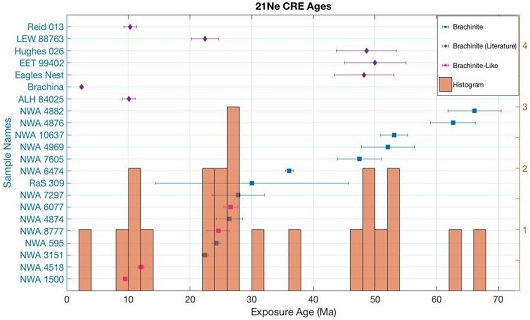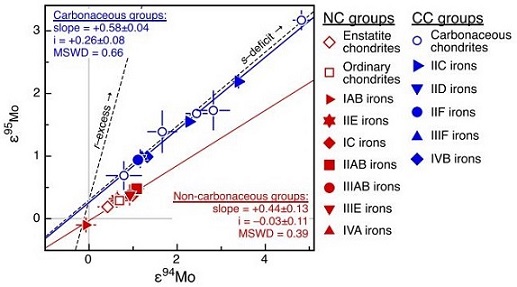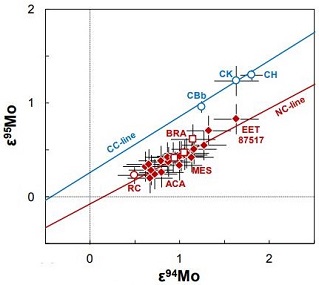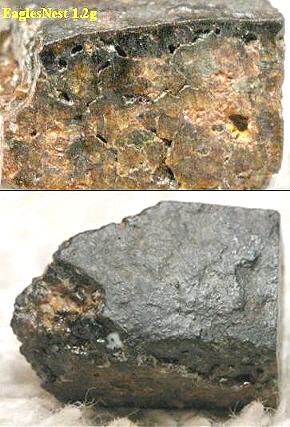Eagles Nest
Brachinite
Found Summer of 1960
no coordinates recorded A well-oriented, fusion-crusted meteoriteWork in progress. A solid natural object reaching a planet’s surface from interplanetary space. Solid portion of a meteoroid that survives its fall to Earth, or some other body. Meteorites are classified as stony meteorites, iron meteorites, and stony-iron meteorites. These groups are further divided according to their mineralogy and Click on Term to Read More weighing 154 g was found in Central Australia lying next to an eagle’s nest. Although the type specimen Brachina was found in central South Australia, differences between it and Eagles Nest in mineralogy, chemistry, and average grain size indicate that they are not fall-related. Analysis and classification of Eagles Nest was conducted at the University of Arizona, Lunar and Planetary Laboratory (W. V. Boynton), and a classification of brachinite was proposed. Eagles Nest shows some differences to most brachinites including its lack of fine-grained assemblages of orthopyroxeneOrthorhombic, low-Ca pyroxene common in chondrites. Its compositional range runs from all Mg-rich enstatite, MgSiO3 to Fe-rich ferrosilite, FeSiO3. These end-members form an almost complete solid solution where Mg2+ substitutes for Fe2+ up to about 90 mol. % and Ca substitutes no more than ~5 mol. % (higher Ca2+ contents occur Click on Term to Read More and opaques lining various olivineGroup of silicate minerals, (Mg,Fe)2SiO4, with the compositional endpoints of forsterite (Mg2SiO4) and fayalite (Fe2SiO4). Olivine is commonly found in all chondrites within both the matrix and chondrules, achondrites including most primitive achondrites and some evolved achondrites, in pallasites as large yellow-green crystals (brown when terrestrialized), in the silicate portion Click on Term to Read More grain boundaries. Goodrich (2010) described reductionOxidation and reduction together are called redox (reduction and oxidation) and generally characterized by the transfer of electrons between chemical species, like molecules, atoms or ions, where one species undergoes oxidation, a loss of electrons, while another species undergoes reduction, a gain of electrons. This transfer of electrons between reactants Click on Term to Read More features that exist on such assemblages in some brachinites, but which are absent in Eagles Nest. It was conjectured that Eagles Nest might have originated from a different brachinite-like parent bodyThe body from which a meteorite or meteoroid was derived prior to its ejection. Some parent bodies were destroyed early in the formation of our Solar System, while others like the asteroid 4-Vesta and Mars are still observable today. Click on Term to Read More.

click on image for a magnified view Diagram credit: Beard et al., 81st MetSoc, #6170 (2018) It has been argued that GRA 06128/9 possibly represents a lower crustal cumulateIgneous rock composed of crystals that have grown and accumulated (often by gravitational settling) in a cooling magma chamber. Click on Term to Read More developed after 10–30% partial meltingAn igneous process whereby rocks melt and the resulting magma is comprised of the remaining partially melted rock (sometimes called restite) and a liquid whose composition differs from the original rock. Partial melting occurs because nearly all rocks are made up of different minerals, each of which has a different melting Click on Term to Read More of a chondritic source on the brachinite parent body. An estimated cooling rate of 10–20°C/year was derived (University of Tokyo; Miyamoto), consistent with a near-surface burial at a depth of 15–20 m. This is contrasted with the deep, ultramaficTerm used for silicate minerals with cations predominantly Mg and/or Fe. Mafic minerals are dominated by plagioclase and pyroxene, and also contain smaller amounts of olivine. Click on Term to Read More mantleMain silicate-rich zone within a planet between the crust and metallic core. The mantle accounts for 82% of Earth's volume and is composed of silicate minerals rich in Mg. The temperature of the mantle can be as high as 3,700 °C. Heat generated in the core causes convection currents in Click on Term to Read More region from which typical brachinites are thought to have formed as residues of partial melting (Ash et al., 2008). It can be inferred from petrological, geochemical, and mineralogical data that GRA 06128/9, and thus all brachinites, originated on a large partially differentiated planetary body distinct from the Earth, Moon, or Mars; interestingly, speculation has surfaced about a possible origin on Venus (Shearer et al., 2008). Nevertheless, in light of its isotopic, chemical, and mineralogical similarities to IAB complex irons such as Caddo County, which similarly contains inclusions of albitic plagioclase (Ab84 mol%), it was considered plausible that this iron asteroid could be the parental source of the brachinites (Nyquist et al., 2009). However, a comparison between brachinites and IAB irons utilizing nucleosynthetic isotopeOne of two or more atoms with the same atomic number (Z), but different mass (A). For example, hydrogen has three isotopes: 1H, 2H (deuterium), and 3H (tritium). Different isotopes of a given element have different numbers of neutrons in the nucleus. Click on Term to Read More anomalies (Mo systematics) shows them to be unrelated.


Diagrams credit:
(left) Kruijer et al., PNAS, vol. 114, #26, p. 6713 (2017), ‘Age of Jupiter inferred from the distinct genetics and formation times of meteorites’ (http://dx.doi.org/10.1073/pnas.1704461114)
(right) Budde et al., 49th LPSC, #2353 (2018) Laboratory melting experiments conducted by Gardner-Vandy et al. (2013) have demonstrated that an FeO-rich (oxidizedOxidation and reduction together are called redox (reduction and oxidation) and generally characterized by the transfer of electrons between chemical species, like molecules, atoms or ions, where one species undergoes oxidation, a loss of electrons, while another species undergoes reduction, a gain of electrons. This transfer of electrons between reactants Click on Term to Read More) R chondrite-like precursor asteroid can undergo significant partial melting (14–31% at ~1250°C) and melt removal to produce a brachinite-like residue, and possibly also a low degree partial melting (<10% at <1250°C) and melt removal to produce a complementary evolved melt having a composition like that of the brachinite-related GRA 06128/9. In their continued effort to attain the composition of the GRA 06128/9 meteorite, considered to be a likely representative of the brachinite parent body feldspathic crustOutermost layer of a differentiated planet, asteroid or moon, usually consisting of silicate rock and extending no more than 10s of km from the surface. The term is also applied to icy bodies, in which case it is composed of ices, frozen gases, and accumulated meteoritic material. On Earth, the Click on Term to Read More, Sosa et al. (2017) employed multiple modeling techniques and conducted melting experiments utilizing R4 chondriteChondrites are the most common meteorites accounting for ~84% of falls. Chondrites are comprised mostly of Fe- and Mg-bearing silicate minerals (found in both chondrules and fine grained matrix), reduced Fe/Ni metal (found in various states like large blebs, small grains and/or even chondrule rims), and various refractory inclusions (such Click on Term to Read More LAP 03639. Their results demonstrate that an R chondrite-like precursor asteroid can undergo low-degree partial melting (~16–20%) at 1140°C with an oxygen fugacityUsed to express the idealized partial pressure of a gas, in this case oxygen, in a nonideal mixture. Oxygen fugacity (ƒO2) is a measure of the partial pressure of gaseous oxygen that is available to react in a particular environment (e.g. protoplanetary disk, Earth's magma, an asteroid's regolith, etc.) and Click on Term to Read More near the iron–wï ¿ ½stite buffer (~IW) to produce a brachinite-like residue and a complementary evolved melt with a composition like that of GRA 06128/9. Additional experimental data and modeling results attained by Lunning et al. (2017) has further constrained the conditions of formation for GRA 06128/9. Their investigation indicates that both equilibriumTerm used to describe physical or chemical stasis. Physical equilibrium may be divided into two types: static and dynamic. Static equilibrium occurs when the components of forces and torques acting in one direction are balanced by components of forces and torques acting in the opposite direction. A system in static Click on Term to Read More and non-equilibrium partial melting (the latter condition corresponding to lower temperatures and degrees of melting) on an oxidized parent body similar to R chondritesChondrites are the most common meteorites accounting for ~84% of falls. Chondrites are comprised mostly of Fe- and Mg-bearing silicate minerals (found in both chondrules and fine grained matrix), reduced Fe/Ni metal (found in various states like large blebs, small grains and/or even chondrule rims), and various refractory inclusions (such Click on Term to Read More, in which 14–22% melt is generated at a temperature of 1120–1140°C and a redoxOxidation and reduction together are called redox (reduction and oxidation) and generally characterized by the transfer of electrons between chemical species, like molecules, atoms or ions, where one species undergoes oxidation, a loss of electrons, while another species undergoes reduction, a gain of electrons. This transfer of electrons between reactants Click on Term to Read More state of IW–IW+1, reproduces most closely the whole rock composition of the GRA 06128/9 meteorite. The authors also posit that unsampled lithologies containing higher silicaSilicon dioxide, SiO2. abundances may have been produced on the GRA 06128/9 (or the brachinite) parent body, in association with very low degrees of non-equilibrium partial melting. These potential lithologies might be akin to the Almahata Sitta trachyandesite samples MS-MU-011/035, which are thought to represent the primary crust of the ureilite parent body. Additional information concerning the origin and petrogenesis of brachinites and GRA 06128/9 can be found on the NWA 3151 and Reid 013 pages. The specimen of Eagles Nest shown above is a 1.2 g fusionProcess in which two lighter atomic nuclei combine to form a heavier atomic nucleus. Very high temperatures are normally required in order for atomic nuclei to collide with sufficient energy to overcome the Coulomb barrier (their mutual electrostatic repulsions). Fusion that occurs under high-temperature conditions is called thermonuclear fusion. Fusion Click on Term to Read More crusted partial slice (photo courtesy of K. Regelman). The top photo below shows a complete slice of Eagles Nest, while the bottom photo shows a small preserved portion of the oriented face of this meteorite exhibiting radial flowlines.

click on image for a magnified view

Photos courtesy of Ken Regelman
For additional information on GRA 06128/9, read the PSRD article by G. Jeffrey Taylor: ‘More Evidence for Multiple Meteorite Magmas‘, Feb 2009.







